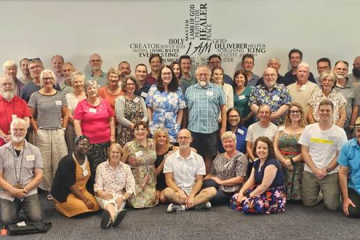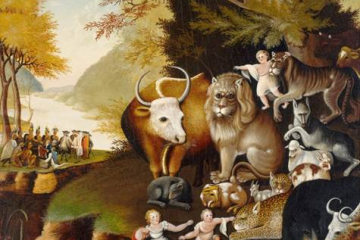14 Feb – Sailing with Jesus – Mark 4:35-41, Psalm 107:1-3, 23-32
Those of you who watch Grand Designs – I know there are a few – may have heard Kevin McCloud last Sunday night refer to origami – the ancient art of paper folding.
One design probably all of us have mastered – at some stage – even before we heard of the ancient art of origami – is a boat; simply by folding a piece of paper in half, folding down the two top corners – you don’t have to do this just yet, but I do have a slide with instructions – folding up the bottom flaps and tucking them in, then opening it out the other way and folding up both sides, pulling it out gently and voila – a boat!
I liked Kevin McCloud’s segment on Sunday night. He looked very proficient and then he went – scrunching paper – “What? It’s a glacier.”
As we know from the stories boats and glaciers don’t always mix. In fact, we know a lot of stories about boats – about boats and storms and boats and epic journeys and boats and giant fish or great sea monsters.
This week I’ve been reading a contemporary novel by Australian writer Patrick Holland, Navigatio, about Saint Brendan, the sixth century monk, who set out in an Irish curragh with a group of monks to find the earthly Paradise. The original, Navigatio Sancti Brendani Abbatis (Voyage of Saint Brendan the Abbot) contains 29 chapters of stories of landing on strange islands – one island is not to be an island at all, but a giant sea monster called Jasconicus – where sometimes they find hospitality – on one island that hospitality is provided by a dog which I thought was rather nice – sometimes they encounter demons and sometimes they keep returning to the same island. Eventually, they reach the earthly Paradise and then return home to die.
There are clearly connections here to other seafaring narratives – Sinbad the Sailor or even the book of Jonah – but these stories are substantially modelled on the gospel narratives, our reading from Mark this morning for instance, and the function of these stories in the Christian community. The casting out of demons, the healing of Peter’s mother-in-law, the calming of the storm can be read simply as miracle stories, as signs of Jesus’ power, but they are also symbolic statements of the gospel and the gospel life; symbolic representations, for the early church and for us, of the journey of discipleship.
And so, our story today, begins with a call to discipleship. Jesus says, “Let us go…” and the disciples take Jesus into the boat and begin a journey “to the other side”. It is evening, however, and without warning – in verse 37 – a great storm arises, the waves beating into the boat and the boat about to sink. Ancient readers would quickly have made the connection between what is described here, and the watery primordial forces of chaos and evil described in Genesis and other parts of the Hebrew Scriptures.
In Navigatio there is also an account of a terrible storm.
When the storm changed directions at a whim [it says] Brendan knew the cause. On the Northern horizon he saw it.
The great dragún blew away all in its path.
We must ply the oars and flee said [Brother] Barinthus.
There is no outrunning this serpent! cried Padraigh bitterly. All is lost!
The men huddled in fear beneath their oilskins. But Brendan stood in the curragh with arms outstretched in the shape of a Cross. And though the sea spewed all around and thrashed the tiny boat, neither boat not man could be moved. Not an inch. And the dragún passed over them as though something more terrible than itself pursued.
I am reminded of the ancient maps, that on their borders, on the borders of the unknown, was written, “There be dragons!” Jesus’ response to the storm tells us that more is at stake here than demonstrating his power over nature. His response is identical to that in Mark 1, to the man with the unclean spirit. He rebukes the wind, just as he rebuked the man, and he demands silence from (literally ‘muzzles’) the sea – just as he did the unclean spirit. What we see here is Jesus contending with demonic and destructive powers. The gospel, according to Mark, is about Jesus freeing people from such forces. The message for us is that the power of the gospel will oppose the personal, social and political forces that oppress, and that discipleship will require us, too, in the Spirit’s power, to challenge such forces.
I have mentioned before, many years ago when I was part of the Baptist fellowship at Woolloomooloo in Sydney, a member of our community preached and – working from a similar gospel text to this – said he did not believe, there in the inner city of Sydney, that we would see the dead raised or blind people miraculously regaining their sight or those in wheelchairs suddenly walking… “But,” he said, ”the signs of God’s liberating work I have seen: prostitutes and drug addicts and drunks have found friends, the homeless share what they have with others, people who’ve always had jobs and people who’ve never had jobs work and worship together, people with mental illness feel safe, those who were excluded are included, and the poor have good news brought to them.“
As Jesus stilled the storm – we are called to still the forces of death and destruction – still.
But it is also clear from this story in Mark that challenging the deep and destructive forces at work in our world is only possible when we are people of faith – people who know not only what this message that liberates, this teaching, is about – remember the question back in the synagogue – but also who it is we follow and trust – here the disciples ask, “Who is this?” To be a disciple, to share in Jesus work of liberation, we need to be people of faith and trust in God, even in the face of our very real fears.
There is another storm described in Navigatio, one that is described in painstaking terrifying detail.
…the ropes…snapped and cracked like bullwhips. The squall came fast across the sea like the claw of a hawk reaching down to grip the curragh.
…Then came the crack of the masthead stay snapping.
Brendan yelled for them to drop the mainsail and he scrabbled at the halliard. The mainyard came sliding down and they leapt on it, spreadeagled to keep it from filling.
They raced before the gale on a single square sail, slung as high as they dared, which was not high…
The men took turns at manning the boat. When they were not at hand they tied themselves to the deck. When at hand they tied themselves to the foremast….
At dawn the strength of the storm was broken.
Barinthus slumped on the gunwale while Brendan kept the wind from pinning the headsail against the mast. Then the sail bellied out and the wind began to pull the boat out of trouble. He sailed and watched the terns where they had been all night, sitting quietly on the water with their eyes closed, not fighting the waves.
This is fiction, beautiful storytelling, but it draws out for me two things.
The very real danger that the disciples were in. These are men who have spent their lifetimes in boats, and this, as we have already observed, is not an ordinary storm. There is an echo here of our reading from the Psalms, of the sailors there crying out to God in their trouble, and just as in the psalm, Jesus does chastise them, but responds quickly to bring them out of their distress.
The second thing is the contrast between the disciples and Jesus. Like the terns, sitting quietly on the water, Jesus is depicted as being “asleep on the cushion”, despite the furore of the storm, the calamity they are facing and the fear of his companions. It is only when the storm has been calmed that he asks them, “Why are you afraid? Have you still no faith?” In Jesus, the disciples and we too, glimpse a vision of another world, a world where the presence and rule of God is in our midst, where we, as we sang this morning ‘know his power in quietness and trust’, as opposed to the world of darkness and chaos, where we imagine ourselves cut off from God’s power.
But how do we get from one place to another? The metaphor of the journey here is our hope. We must journey on. We must keep moving, through the darkness, through the dangers, through the period of calm and delight, whether we think we have no faith or just a little faith along the way our faith will grow, our courage to challenge the evil around us will increase and our vision of the world we are journeying towards will grow clearer.
In the new small group that started on Thursday night we heard from Christian writer, Brian McLaren, speaking of faith in God as a quest, and it was this quote that captured my imagination:
For us, he said, faith is like a ship that we’re sailing on. Our beliefs are like planks in the hull and the trials and disappointments and enigmas of life are like the storms and icebergs and reefs that sometimes threaten to sink us. Sometimes old planks spring a leak and have to be replaced – often when we’re far from shore. We might say that God is the source and the goal of our quest, and that God is the mysterious sea upon which we sail, and that God is the wind we raise our sails to receive. We might say that fellowship is what we experience with fellow travellers on our ship of faith. We might even say that theology is the necessary maintenance of the hull and decks and sails so that our ship stays seaworthy for generations to come. In all of this of course we need to remember that maintenance of the ship is not the point….the quest is…our experience of and with God.
“Who is this?” the disciples ask. That is the question that we are answering day by day as we explore what it means to follow Jesus today – to sail with Jesus today.
There’s just one tiny reference in this passage that I had never noticed before this week – and that is verse 36; The disciples “took him with them in the boat…” and ”Other boats were with him.” Other boats were with him. We are the other boats. Perhaps we are all in one – Canberra Baptist Church learning to sail together. Perhaps it is our Baptist Association learning how to navigate the enigmas of life in the twenty-first century together. Perhaps it is just you dealing with the difficulties and disappointments you face. But we are still all following the ship carrying our Savour and our hope, Jesus.
Charles Spurgeon, the great Baptist preacher wrote of this verse, “May our hearts make Jesus their anchor, their rudder, their lighthouse, their life-boat, and their harbour.… let us follow ever in his wake, mark his signals, steer by his chart, and never fear while he is within hail.” Amen.
Can I invite you know to take your piece of paper and write on it your prayer – your cry in the storm you are facing or your thanks for the calm you have reached, your request for faith to respond to the challenges that are all around us – and then you are invited to make that into a boat – as we listen to the words of this old hymn:
Jesus, Saviour, pilot me, over life’s tempestuous sea;
unknown waves before me roll, hiding rock and treacherous shoal.
Chart and compass come from thee; Saviour, pilot me.


